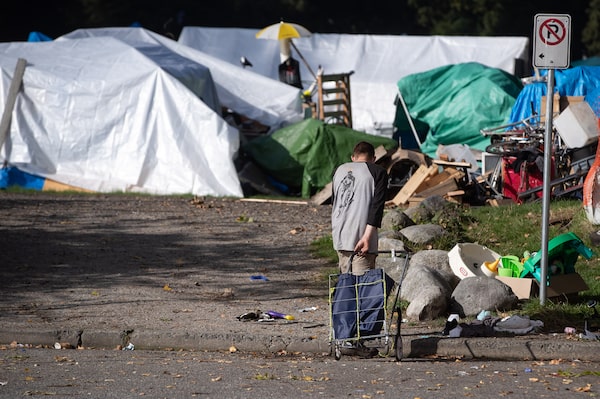
A person pulls a cart at a homeless encampment at Strathcona Park, in Vancouver, on October 7, 2020.DARRYL DYCK/The Canadian Press
When I moved to London for the second time in my life, in the early 2000s, I was struck by a highly visible change: The street-level misery that had defined the great metropolis in the 1980s had all but vanished. Gone were the bodies huddled under blankets around the edges of Trafalgar Square, the rows of beggars along Oxford Street and the Strand, the encampments beneath the arches of Waterloo Bridge.
It was the first and only time I have seen a serious urban “rough sleeping” problem (as street homelessness is more accurately known in Britain) more or less fully solved, humanely and comprehensively.
London didn’t “solve” it the way European cities do – by force-bussing sleepers to shelters on the edge of town. It didn’t solve it by making housing more affordable; this happened as its housing was becoming among the world’s most expensive. In fact, it wasn’t solved by London at all. The solution arrived in the late 1990s, before London got its first mayor and municipal government in 2000. The solution was national, and involved many institutions working in concert under goal-driven leadership.
The London example is suddenly of great interest to cities across Canada. It should be studied more closely by Ottawa.
The parks and alleys of Canadian cities are jammed. Vancouver’s Downtown Eastside and Toronto’s Moss Park are scenes of chaotic mass deprivation. Smaller cities such as Abbotsford, B.C., London, Ont., and Charlottetown, PEI, have been overwhelmed with rough-sleeping populations.
It’s not an economic crisis: It’s occurring exclusively in cities with full employment, buoyant economies and low poverty rates (economically deprived cities tend to have plenty of cheap housing).
It began during the pandemic, when shelters cut populations to meet hygiene rules and parks began to fill up. It got worse when aid payments stopped and emergencies of mental health and addiction multiplied. And it is exacerbated as low-end rooming houses are bought up to fill those cities’ larger crises of mid-priced housing supply, throwing people into a shelter system that can’t handle them.
It’s been apparent for some time that the problem is beyond the scope of cities. That became evident this month, when Toronto faced a new crisis in which scores of asylum seekers, mainly families from African countries, found themselves without shelter spaces and sleeping on the sidewalk of Peter Street, outside the shelter authority’s offices. For weeks, they were caught in a tug-of-war between Ottawa (responsible for immigration) and the city (responsible for shelter).
That situation, which seemed to be resolved this week with emergency municipal shelter financing, drew attention to the heterogenous nature of rough-sleeping populations. People end up on the street for a bewildering variety of reasons; likewise, what is required to get them off the street varies from person to person.
It also drew attention to the fact that Ottawa, despite having a national “homelessness strategy” budgeted at nearly $4-billion over nine years, does not really have a strategy at all. As the auditor-general recently noted, the federal government does not know whether its expenditures have prevented or reduced homelessness at all.
This is where Ottawa needs to learn from what I witnessed in London. When what became Britain’s Rough Sleepers Unit was created in 1997, it was a high-profile initiative with an outspoken “homelessness czar” in charge (Louise Casey, the deputy director of a rough-sleepers charity) and a hard target: cut the numbers of people on the streets by two-thirds within three years.
It accomplished this by not just filling the demand for various sorts of shelter – a lot of its budget was spent upgrading the lowest-end rental accommodations to a level that would make them tolerable to someone in an encampment – but also by slashing the supply of homeless people. The RSU worked directly with the major sources of homelessness – the military, the penal system and the care-home system, as well as the usual mental-health and addiction bodies – to ensure that troubled people who left those institutions would be given places to stay and wouldn’t end up in the street.
In practice, I found that the RSU sent out hundreds of staff and volunteers every day to have one-on-one meetings with rough sleepers, focused on one question: What would it take to get you off the street? They were expected to have same-day responses, in the form of a wide array of shelters, hostels, alcohol-permitting “wet spaces,” shelter-to-home transition facilities, residential hotels and more permanent accommodations.
This effort was expensive, and it was eventually augmented with a more punitive system, then abandoned in 2010. But for a decade, it worked: One of the world’s worst rough-sleeping crises was all but solved. The benefits to London, to Britain, and to the thousands of people taken off the streets were immeasurable.
And it provided a lesson to the world: People sleeping outdoors are not an unavoidable part of urban life. Their problems have solutions, if we have the will.
 Doug Saunders
Doug Saunders